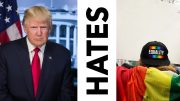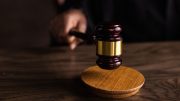By: Al Gentile/TRT Reporter—
The first time Narin Khem traveled to Cambodia, it was to marry a man she did not know.
“That was an experience,” said Khem, a Lowell, Mass. resident who identifies as bisexual. “At the time, I felt I was giving up on myself just to make my mom happy.”
When Khem came out to her mother about being bisexual, she said her mother’s traditional outlook on sexual orientation led to a conflict.
“Being from a traditional family she wasn’t used to that,” Khem said. “My mom was really having trouble with it to the point that she actually forced me into dating a man.”
In order to correct what Khem’s mother saw as a flaw, Khem endured six years of marriage before getting a divorce.
Khem’s story follows a trend of discrimination, misconception, and a statistically lower quality of life for bisexual people, according to a September 2016 report by the Movement Advancement Project (MAP). Khem’s experience is indicative of the experiences of many bisexual people when it comes to fully embracing their sexual orientation.
“Invisible Majority: The Disparities Facing Bisexual People and How to Remedy Them” reports that approximately 52 percent of the LGB community identify as bisexual. Of the respondents, only 28 percent reported that all or most of the important people in their lives know about their sexual orientation. The study highlights the fact that bisexual people experience significant amounts of discrimination in the workplace, are victims of violence because of their sexual orientation, and are more likely to have mental health issues and substance abuse problems due to violence and discrimination.
Heron Greenesmith, senior policy analyst for MAP, and one of the lead authors of the report, said the difficulties bisexual people face come from all sides and harbor deep consequences.
“Bisexual people face bias and discrimination in life and in families, and at school, that may lead to negative outcomes like homelessness, or lower earning power that in turn can even affect health, and have specific experiences like interpartner violence that all combine into this stew of lower quality of life, lower health, and poor outcomes,” Greenesmith said.
The MAP report shows bisexual people are significantly more likely to engage in self-harm such as drug abuse and suicidal ideation. Khem’s struggle with her sexuality lead her down a path of substance abuse, like many others.
“That was my way of getting through things,” she said. “I have thought about suicide.”
Jennifer Rheume, a bisexual woman who grew up in Barrington, N.H., said the fear of isolation and misconceptions kept her from coming out until high school.
“When I was in middle school before I came out, I definitely had a hard time and was very depressed,” Rheume said. “I just felt very alone and I didn’t know where to go with the emotions and feelings and all that.”
Robyn Ochs, a bisexual activist, author, and educator, said the lack of representation of bisexual people stems from a general binary approach to sexuality.
“Western cultures tend to squeeze things in simple—and false—binaries: black/white, man/woman, Democrat/Republican, gay/straight. We are comfortable with simple narratives and simple messages,” Ochs said in an email to _The Rainbow Times_. “Marginalized communities, in particular, often feel a need to have [a] clear sense of us/them, safe/unsafe. Bi+ people, as a result, have often been distrusted, marginalized, excluded, and perceived as a threat.”
The term “Bi+” is used to describe people who are attracted to more than one gender and can include those who are polysexual or pansexual.
Even with media becoming more sensitive to LGBTQ issues in recent years, Ochs said bisexual people are overwhelmingly left out of important dialogues around sexual orientation.
“Over-simplistic language such as ‘gay and straight’ or ‘the gay community’ is damaging, because it perpetuates bi+ erasure and invisibility,” Ochs said. “And the mainstream and LGBT media could do a much better job covering bi+ issues. If you do a review of coverage, I believe you will find very little specifically about bi+ people. Most bi conferences and events are not covered in the media.”
The MAP report recommends LGBTQ organizations must put more focus on the majority of its target population.
“Organizations that say they are supporting the LGBT community need to realize that bisexual folks make up the majority of the LGBT population,” Greenesmith said.
Coming out
Khem said when she first came out as bisexual to her friends while in high school, a line was drawn. In one case, a long-time friend of Khem’s severed ties because of the misconceptions facing bisexual people.
“One of my closest friends at the time didn’t agree with who I am,” Khem said. “Just because I came out as a bisexual, she would not try to understand that.”
In her relationships, Khem said one of the most prevalent misconceptions was the inability of bisexual people to be faithful in a relationship.
“We always have this misconception that we’re greedy, or we’re cheaters,” Khem said. “You just can’t put that on sexuality.”
Khem even said she stopped identifying as bisexual to avoid the misconceptions bisexual people face.
“I started to not label myself so I could get to know a person. There’s no chance to be who you are,” Khem said. “That was the only thing I could do with all the misunderstanding.”
Rheume also stopped identifying as bisexual in order to avoid the stigma.
“I feel like it’s more fluid than people like to consider it, so people need to put that label of bi, gay, or lesbian,” Rheume said. “I just never felt it was right to put that label on, then the bisexual label just had so much negative connotation to it.”
Moving forward
Although the bi+ community continues to face challenges from within the larger LGBTQ and mainstream communities, often it simply boils down to a common saying: Just “live and let live.”
“People should just stop getting so upset about the way people identify themselves, and just focus on themselves,” Rheume said. “Everyone needs to grow and figure out who they are without someone coming down on them and bring[ing] them down.”
The way the bisexual community is seen in the LGBTQ community at large needs to be addressed, according to Ochs.
“The bottom line is that bi+ people are tired of being ignored and excluded, and of having the legitimacy of our identities and of our contributions to the LGBTQ+ movement denied,” Ochs said.
Khem said reaching out to friends and parts of her family helped her endure her struggle.
“Don’t hide who you are because of how someone else feels,” Khem said. “A good support system … was a big part of getting through it.”
Battling with bisexual invisibility, discrimination, and alienation is not a struggle anyone should do alone. BiNet, the oldest national non-profit organization to support bisexual people, offers advice, media content, and connections to groups and individuals who can offer support.
The Human Rights Campaign also works to bring more visibility to issues affecting bisexual people, as well as people from all sexual orientation backgrounds.







